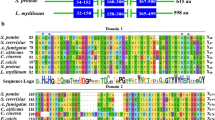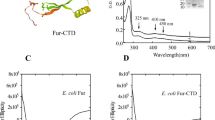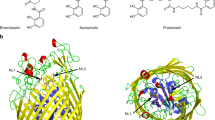Abstract
The EfeUOB system of Escherichia coli is a tripartite, low pH, ferrous iron transporter. It resembles the high-affinity iron transporter (Ftr1p-Fet3p) of yeast in that EfeU is homologous to Ftr1p, an integral-membrane iron-permease. However, EfeUOB lacks an equivalent of the Fet3p component—the multicopper oxidase with three cupredoxin-like domains. EfeO and EfeB are periplasmic but their precise roles are unclear. EfeO consists primarily of a C-terminal peptidase-M75 domain with a conserved ‘HxxE’ motif potentially involved in metal binding. The smaller N-terminal domain (EfeO-N) is predicted to be cupredoxin (Cup) like, suggesting a previously unrecognised similarity between EfeO and Fet3p. Our structural modelling of the E. coli EfeO Cup domain identifies two potential metal-binding sites. Site I is predicted to bind Cu2+ using three conserved residues (C41 and 103, and E66) and M101. Of these, only one (C103) is conserved in classical cupredoxins where it also acts as a Cu ligand. Site II most probably binds Fe3+ and consists of four well conserved surface Glu residues. Phylogenetic analysis indicates that the EfeO-Cup domains form a novel Cup family, designated the ‘EfeO-Cup’ family. Structural modelling of two other representative EfeO-Cup domains indicates that different subfamilies employ distinct ligand sets at their proposed metal-binding sites. The ~100 efeO homologues in the bacterial sequence databases are all associated with various iron-transport related genes indicating a common role for EfeO-Cup proteins in iron transport, supporting a new copper-iron connection in biology.






Similar content being viewed by others
References
Adman ET (1991) Copper protein structures. Adv Protein Chem 42:145–197
Adman ET, Godden JW, Turley S (1995) The structure of copper-nitrite reductase from Achromobacter cycloclastes at five pH values, with NO2 − bound and with type II copper depleted. J Biol Chem 270:27458–27474
Altschul SF, Gish W, Miller W, Myers EW, Lipman DJ (1990) Basic local alignment search tool. J Mol Biol 215:403–410
Andrews SC, Robinson AK, Rodriguez-Quinones F (2003) Bacterial iron homeostasis. FEMS Microbiol Rev 27:215–237
Askwith C, Kaplan J (1997) An oxidase-permease-based iron transport system in Schizosaccharomyces pombe and its expression in Saccharomyces cerevisiae. J Biol Chem 272:401–405
Askwith C, Kaplan J (1998) Iron and copper transport in yeast and its relevance to human disease. Trends Biochem Sci 23:135–138
Baichoo N, Wang T, Ye R, Helmann JD (2002) Global analysis of the Bacillus subtilis Fur regulon and the iron starvation stimulon. Mol Microbiol 45:1613–1629
Bairoch A, Apweiler R, Wu CH, Barker WC, Boeckmann B, Ferro S, Gasteiger E, Huang H, Lopez R, Magrane M, Martin MJ, Natale DA, O’Donovan C, Redaschi N, Yeh LS (2005) The universal protein resource (UniProt). Nucleic Acids Res 33:D154–D159
Bendtsen JD, Nielsen H, von Heijne G, Brunak S (2004) Improved prediction of signal peptides: SignalP 3.0. J Mol Biol 340:783–795
Berman HM, Westbrook J, Feng Z, Gilliland G, Bhat TN, Weissig H, Shindyalov IN, Bourne PE (2000) The protein data bank. Nucleic Acids Res 28:235–242
Bracken CS, Baer MT, Abdur-Rashid A, Helms W, Stojiljkovic I (1999) Use of heme-protein complexes by the Yersinia enterocolitica HemR receptor: histidine residues are essential for receptor function. J Bacteriol 181:6063–6072
Braun V, Hantke K, Koster W (1998) Bacterial iron transport: mechanisms, genetics, and regulation. In: Sigel A, Sigel H (eds) Metal ions in biological systems. Dekker, New York, pp 67–145
Bryson K, McGuffin LJ, Marsden RL, Ward JJ, Sodhi JS, Jones DT (2005) Protein structure prediction servers at University College London. Nucleic Acids Res 33:W36–W38
Cao J, Woodhall MR, Alvarez J, Cartron ML, Andrews SC (2007) EfeUOB (YcdNOB) is a tripartite, acid-induced and CpxAR-regulated, low-pH Fe2+ transporter that is cryptic in Escherichia coli K-12 but functional in E. coli O157:H7. Mol Microbiol 65:857–875
Carrell CJ, Sun D, Jiang S, Davidson VL, Mathews FS (2004) Structural studies of two mutants of amicyanin from Paracoccus denitrificans that stabilize the reduced state of the copper. Biochemistry 43:9372–9380
Carrondo MA (2003) Ferritins, iron uptake and storage from the bacterioferritin viewpoint. EMBO J 22:1959–1968
Cartron ML, Maddocks S, Gillingham P, Craven CJ, Andrews SC (2006) Feo—transport of ferrous iron into bacteria. Biometals 19:143–157
Cartron ML, Mitchell SA, Woodhall MR, Andrews SC, Watson KA (2007) Preliminary X-ray diffraction analysis of YcdB from Escherichia coli: a novel haem-containing and Tat-secreted periplasmic protein with a potential role in iron transport. Acta Crystallogr Sect F 63:37–41
Chiancone E, Ceci P, Ilari A, Ribacchi F, Stefanini S (2004) Iron and proteins for iron storage and detoxification. Biometals 17:197–202
Ciria R, Abreu-Goodger C, Morett E, Merino E (2004) GeConT: gene context analysis. Bioinformatics 20:2307–2308
Cobbett C, Goldsbrough P (2002) Phytochelatins and metallothioneins: roles in heavy metal detoxification and homeostasis. Annu Rev Plant Biol 53:159–182
Collaborative Computational Project N (1994) The CCP4 suite: programs for protein crystallography. Acta Crystallogr D B 50:760–763
Crane BR, Di Bilio AJ, Winkler JR, Gray HB (2001) Electron tunneling in single crystals of Pseudomonas aeruginosa azurins. J Am Chem Soc 123:11623–11631
Cuff JA, Clamp ME, Siddiqui AS, Finlay M, Barton GJ (1998) JPred: a consensus secondary structure prediction server. Bioinformatics 14:892–893
De Freitas J, Wintz H, Kim JH, Poynton H, Fox T, Vulpe C (2003) Yeast, a model organism for iron and copper metabolism studies. Biometals 16:185–197
De Silva DM, Askwith CC, Eide D, Kaplan J (1995) The FET3 gene product required for high affinity iron transport in yeast is a cell surface ferroxidase. J Biol Chem 270:1098–1101
Debut AJ, Dumay QC, Barabote RD, Saier MH Jr (2006) The iron/lead transporter superfamily of Fe2+/Pb2+ uptake systems. J Mol Microbiol Biotechnol 11:1–9
Delano W (2002) The PyMOL molecular graphics system. www.pymol.org. Accessed Apr 2009
Dennison C (2005) Investigating the structure and function of cupredoxins. Coord Chem Rev 249:3025–3054
Ducros V, Brzozowski AM, Wilson KS, Ostergaard P, Schneider P, Svendson A, Davies GJ (2001) Structure of the laccase from Coprinus cinereus at 1.68 Å resolution: evidence for different type 2 Cu-depleted isoforms. Acta Crystallogr D 57:333–336
Durley R, Chen L, Lim LW, Mathews FS, Davidson VL (1993) Crystal structure analysis of amicyanin and apoamicyanin from Paracoccus denitrificans at 2.0 Å and 1.8 Å resolution. Protein Sci 2:739–752
Fang H-M, Wang Y (2002) Characterization of iron-binding motifs in Candida albicans high-affinity iron permease CaFtr1p by site-directed mutagenesis. Biochem J 368:641–647
Finn RD, Mistry J, Schuster-Bockler B, Griffiths-Jones S, Hollich V, Lassmann T, Moxon S, Marshall M, Khanna A, Durbin R, Eddy SR, Sonnhammer EL, Bateman A (2006) Pfam: clans, web tools and services. Nucleic Acids Res 34:D247–D251
Fu Y, Lee H, Collins M, Tsai HF, Spellberg B, Edwards JE Jr, Kwon-Chung KJ, Ibrahim AS (2004) Cloning and functional characterization of the Rhizopus oryzae high affinity iron permease (rFTR1) gene. FEMS Microbiol Lett 235:169–176
Goodford PJ (1985) A computational procedure for determining energetically favorable binding sites on biologically important macromolecules. J Med Chem 28:849–857
Gough J, Karplus K, Hughey R, Chothia C (2001) Assignment of homology to genome sequences using a library of hidden Markov models that represent all proteins of known structure. J Mol Biol 313:903–919
Grass G, Wong MD, Rosen BP, Smith RL, Rensing C (2002) ZupT is a Zn(II) uptake system in Escherichia coli. J Bacteriol 184:864–866
Grifantini R, Sebastian S, Frigimelica E, Draghi M, Bartolini E, Muzzi A, Rappuoli R, Grandi G, Genco CA (2003) Identification of iron-activated and -repressed Fur-dependent genes by transcriptome analysis of Neisseria meningitidis group B. Proc Natl Acad Sci USA 100:9542–9547
Hantke K (1987) Ferrous iron transport mutants in Escherichia coli K12. FEMS Microbiol Lett 44:53–57
Inoue T, Nishio N, Suzuki S, Kataoka K, Kohzuma T, Kai Y (1999) Crystal structure determinations of oxidized and reduced pseudoazurins from Achromobacter cycloclastes. Concerted movement of copper site in redox forms with the rearrangement of hydrogen bond at a remote histidine. J Biol Chem 274:17845–17852
Ishida T, Kinoshita K (2007) PrDOS: prediction of disordered protein regions from amino acid sequence. Nucleic Acids Res 35:W460–W464
Jones DT, Bryson K, Coleman A, McGuffin LJ, Sadowski MI, Sodhi JS, Ward JJ (2005) Prediction of novel and analogous folds using fragment assembly and fold recognition. Proteins 61:143–151
Kehres DG, Zaharik ML, Finlay BB, Maguire ME (2000) The NRAMP proteins of Salmonella typhimurium and Escherichia coli are selective manganese transporters involved in the response to reactive oxygen. Mol Microbiol 36:1085–1100
Kehres DG, Janakiraman A, Slauch JM, Maguire ME (2002) SitABCD is the alkaline Mn2+ transporter of Salmonella enterica Serovar Typhimurium. J Bacteriol 184:3159–3166
Kelley LA, MacCallum RM, Sternberg MJ (2000) Enhanced genome annotation using structural profiles in the program 3D-PSSM. J Mol Biol 299:499–520
Klaassen CD, Liu J, Choudhuri S (1999) Metallothionein: an intracellular protein to protect against cadmium toxicity. Annu Rev Pharmacol Toxicol 39:267–294
Kojima T, Binz PA, Kägi JHR (1999) Nomenclature of metallothionein: proposal for a revision. In: Klaassen CD (ed) Metallothionein IV. Birkhauser, Boston, pp 7–13
Laskowski RA, MacArthur MW, Moss DS, Thornton JM (1993) PROCHECK: a program to check the stereochemical quality of protein structures. J Appl Crystallogr 26:283–291
Lees JG, Miles AJ, Wien F, Wallace BA (2006) A reference database for circular dichroism spectroscopy covering fold and secondary structure space. Bioinformatics 22:1955–1962
Makui H, Roig E, Cole ST, Helmann JD, Gros P, Cellier MF (2000) Identification of the Escherichia coli K-12 Nramp orthologue (MntH) as a selective divalent metal ion transporter. Mol Microbiol 35:1065–1078
Marsden RL, McGuffin LJ, Jones DT (2002) Rapid protein domain assignment from amino acid sequence using predicted secondary structure. Protein Sci 11:2814–2824
Marti-Renom MA, Stuart AC, Fiser A, Sanchez R, Melo F, Sali A (2000) Comparative protein structure modeling of genes and genomes. Annu Rev Biophys Biomol Struct 29:291–325
McGuffin L (2007) Benchmarking consensus model quality assessment for protein fold recognition. BMC Bioinformatics 8:345
McGuffin LJ (2008) The ModFOLD server for the quality assessment of protein structural models. Bioinformatics 24:586–587
McGuffin LJ, Bryson K, Jones DT (2001) What are the baselines for protein fold recognition? Bioinformatics 17:63–72
Messerschmidt A, Luecke H, Huber R (1993) X-ray structures and mechanistic implications of three functional derivatives of ascorbate oxidase from zucchini: reduced, peroxide and azide forms. J Mol Biol 230:997–1014
Messerschmidt A, Huber R, Poulos T, Wieghardt K (2001) Handbook of metalloproteins. Wiley, New York
Mulder NJ, Apweiler R, Attwood TK et al (2007) New developments in the InterPro database. Nucleic Acids Res 35:D224–D228
Murphy A, Taiz L (1995) Comparison of metallothionein gene expression and nonprotein thiols in ten arabidopsis ecotypes (Correlation with copper tolerance). Plant Physiol 109:945–954
Murzin AG, Brenner SE, Hubbard T, Chothia C (1995) SCOP: a structural classification of proteins database for the investigation of sequences and structures. J Mol Biol 247:536–540
Nicholas KB, Nicholas HB, DW D (1997) GeneDoc: analysis and visualization of genetic variation. EMBNEW. NEWS 4:14. www.nrbsc.org/gfx/genedoc. Accessed Feb 2009
Ollinger J, Song KB, Antelmann H, Hecker M, Helmann JD (2006) Role of the Fur regulon in iron transport in Bacillus subtilis. J Bacteriol 188:3664–3673
Palmiter RD (1998) The elusive function of metallothioneins. Proc Natl Acad Sci USA 95:8428–8430
Paronetto MP, Miele R, Maugliani A, Borro M, Bonaccorsi di Patti MC (2001) Cloning of Pichia pastoris Fet3: insights into the high affinity iron uptake system. Arch Biochem Biophys 392:162–167
Pastore C, Franzese M, Sica F, Temussi P, Pastore A (2007) Understanding the binding properties of an unusual metal-binding protein-a study of bacterial frataxin. FEBS J 274:4199–4210
Severance S, Chakraborty S, Kosman DJ (2004) The Ftr1p iron permease in the yeast plasma membrane: orientation, topology and structure–function relationships. Biochem J 380:487–496
Solioz M, Vulpe C (1996) CPx-type ATPases: a class of P-type ATPases that pump heavy metals. Trends Biochem Sci 21:237–241
Solomon EI, Sundaram UM, Machonkin TE (1996) Multicopper oxidases and oxygenases. Chem Rev 96:2563–2606
Stearman R, Yuan DS, Yamaguchi-Iwai Y, Klausner RD, Dancis A (1996) A permease-oxidase complex involved in high-affinity iron uptake in yeast. Science 271:1552–1557
Stintzi A, Barnes C, Xu J, Raymond KN (2000) Microbial iron transport via a siderophore shuttle: a membrane ion transport paradigm. Proc Natl Acad Sci USA 97:10691–10696
Sturm A, Schierhorn A, Lindenstrauss U, Lilie H, Bruser T (2006) YcdB from Escherichia coli reveals a novel class of Tat-dependently translocated hemoproteins. J Biol Chem 281:13972–13978
Suzuki S, Kataoka K, Yamaguchi K (2000) Metal coordination and mechanism of multicopper nitrite reductase. Acc Chem Res 33:728–735
Tamura K, Dudley J, Nei M, Kumar S (2007) MEGA4: molecular evolutionary genetics analysis (MEGA) software version 4.0. Mol Biol Evol 24:1596–1599
Taylor AB, Stoj CS, Ziegler L, Kosman DJ, Hart PJ (2005) The copper-iron connection in biology: structure of the metallo-oxidase Fet3p. Proc Natl Acad Sci USA 102:15459–15464
Thompson JD, Higgins DG, Gibson TJ (1994) CLUSTAL W: improving the sensitivity of progressive multiple sequence alignment through sequence weighting, position-specific gap penalties and weight matrix choice. Nucleic Acids Res 22:4673–4680
Wandersman C, Delepelaire P (2004) Bacterial iron sources: from siderophores to hemophores. Annu Rev Microbiol 58:611–647
Ward JJ, Sodhi JS, McGuffin LJ, Buxton BF, Jones DT (2004) Prediction and functional analysis of native disorder in proteins from the three kingdoms of life. J Mol Biol 337:635–645
Wheeler DL, Barrett T, Benson DA et al (2006) Database resources of the National Center for Biotechnology Information. Nucleic Acids Res 34:D173–D180
Whitmore L, Wallace BA (2004) DICHROWEB, an online server for protein secondary structure analyses from circular dichroism spectroscopic data. Nucleic Acids Res 32:W668–W673
Yang ZR, Thomson R, McNeil P, Esnouf RM (2005) RONN: the bio-basis function neural network technique applied to the detection of natively disordered regions in proteins. Bioinformatics 21:3369–3376
Zaitseva I, Zaitsev V, Card G, Moshkov K, Bax B, Ralph A, Lindley P (1996) The X-ray structure of human serum ceruloplasmin at 3.1 Å: nature of the copper centres. J Biol Inorg Chem 1:15–23
Acknowledgments
We thank Peter Goodford and Jim Dunwell for helpful discussions in the preparation of the manuscript. We also thank Liam McGuffin for the helpful discussions related with the evaluation of structural models. Authors thank FELIX trust, Biotechnology and Biological Sciences Research (BBSRC) and Lister Institute of Preventive Medicine for providing funding for this study. We thank Sue Mitchell and Nick Spencer (Structural Biology Unit, The Biocentre) for technical support.
Author information
Authors and Affiliations
Corresponding author
Electronic supplementary material
Below is the link to the electronic supplementary material.
Rights and permissions
About this article
Cite this article
Rajasekaran, M.B., Nilapwar, S., Andrews, S.C. et al. EfeO-cupredoxins: major new members of the cupredoxin superfamily with roles in bacterial iron transport. Biometals 23, 1–17 (2010). https://doi.org/10.1007/s10534-009-9262-z
Received:
Accepted:
Published:
Issue Date:
DOI: https://doi.org/10.1007/s10534-009-9262-z




